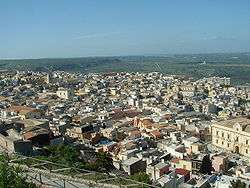Melilli
| Melilli | |
|---|---|
| Comune | |
| Comune di Melilli | |
 | |
 Melilli Location of Melilli in Italy | |
| Coordinates: 37°11′N 15°7′E / 37.183°N 15.117°ECoordinates: 37°11′N 15°7′E / 37.183°N 15.117°E | |
| Country | Italy |
| Region | Sicily |
| Province | Province of Syracuse (SR) |
| Frazioni | Villasmundo, Città Giardino, Marina di Melilli |
| Government | |
| • Mayor | Giuseppe Carta |
| Area | |
| • Total | 136.42 km2 (52.67 sq mi) |
| Elevation | 310 m (1,020 ft) |
| Population (30 November 2017)[1] | |
| • Total | 13,533 |
| • Density | 99/km2 (260/sq mi) |
| Demonym(s) | Melillesi |
| Time zone | UTC+1 (CET) |
| • Summer (DST) | UTC+2 (CEST) |
| Postal code | 96010 |
| Dialing code | 0931 |
| Patron saint | Saint Sebastian |
| Saint day | 4th of May |
| Website | Official website |
Melilli (Sicilian: Miliddi) is a comune (municipality) in the Province of Syracuse, Sicily (southern Italy), located about 190 kilometres (120 mi) southeast of Palermo and about 20 kilometres (12 mi) northwest of Syracuse.
Geography
Melilli stands at about 310 metres (1,020 ft) above sea level close to the Monti Climiti chain, overlooking the Megara bay and the industrial district of Augusta-Priolo.
Melilli borders the following municipalities: Augusta, Carlentini, Priolo Gargallo, Syracuse, Sortino.
History
The human presence in the area is attested since the Bronze Age. Its strategic situation between the major cities of Augusta and Syracuse has played a critical role in its growth. In the feudal age, it became a dominion of the Augusta County.
It managed to revive after two devastating quakes in 1542 and 1693. Since 1842 it has been an autonomous city.
Main sights
The Chiesa Madre (Mother Church), dedicated to Saint Nicholas, has a ceiling painted with the Triumph of the Faith by Olivo Sozzi. The church of San Sebastiano, dating from the 18th century, houses various paintings by Sozzi, among which are a Coronation of Saint Sebastian and The Triumph of the Faith, and a marble altarpiece representing the Deposition of St. Bartholomew.
Nature
The River Marcellino, flowing nearby, offers naturalistic spots and an old necropolis. The neighboring salt-mines of Augusta were an important economic resource as far as the end of World War II.
Economy
Culture
Feasts in the town include:
- Carnival
- Christ's nativity representation (during Christmas)
- Holy week
- Feast of Saint Sebastian - 4 May (Patron Saint of the town)
Twin towns

